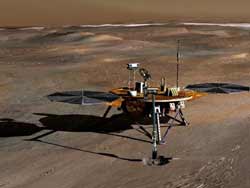NASA to power off Mars Lander Phoenix instruments
29 Oct 2008
Los Angeles: The National Aeronautics and Space Administration (NASA) has decided to shut down key instruments on board the Phoenix spacecraft in a move to conserve power after five months of digging up Martian soil.
Phoenix had landed on Mars in May 2008, with the objective to study the arctic environment and its ability to support primitive life. Phoenix has been struggling with fewer hours of sunlight reaching its solar panels, causing it to use up stored power, and not being able to generate enough to recharge.
 In a statement on its website, NASA said it was a ''race against time and the elements'' for engineers with the space agency's Phoenix Mars Lander mission in a bid to extend the lander's survival by gradually shutting down some of its instruments and heaters.
In a statement on its website, NASA said it was a ''race against time and the elements'' for engineers with the space agency's Phoenix Mars Lander mission in a bid to extend the lander's survival by gradually shutting down some of its instruments and heaters.
NASA said that while it was originally scheduled to last 90 days, Phoenix has completed a fifth month of exploration in the Martian arctic. The Martian northern hemisphere is now shifting from summer to fall, and the lander is generating less power due to shorter days and fewer hours of sunlight reaching its solar panels. Simultaneously, the spacecraft requires more power to run several survival heaters that allow it to operate even as temperatures decline.
"If we did nothing, it wouldn't be long before the power needed to operate the spacecraft would exceed the amount of power it generates on a daily basis," said Phoenix Project Manager Barry Goldstein of NASA's Jet Propulsion Laboratory, Pasadena, California.
"By turning off some heaters and instruments, we can extend the life of the lander by several weeks and still conduct some science."
Over the next several weeks, four survival heaters will be shut down one at a time, in a bid to conserve power. The heaters serve the purpose of keeping the electronics within tested survivable limits.
NASA says that as each heater is disabled, some of the instruments are also expected to cease operations. The energy saved is intended to power the lander's main camera and meteorological instruments until the very end of the mission. The agency's engineers have sent commands to disable the first heater, which warms Phoenix's robotic arm, robotic-arm camera, and thermal and evolved-gas analyzer (TEGA), an instrument that bakes and sniffs Martian soil to assess volatile ingredients.
Shutting down this heater is expected to save 250 watt-hours of power per Martian day, NASA said.
The Phoenix team has parked the robotic arm on a representative patch of Martian soil. No additional soil samples will be gathered. The thermal and electrical-conductivity probe (TECP), located on the wrist of the arm, has been inserted into the soil and will continue to measure soil temperature and conductivity, along with atmospheric humidity near the surface. The probe does not need a heater to operate and should continue to send back data for weeks.
When power levels necessitate further action, Phoenix engineers would disable a second heater, which serves the lander's pyrotechnic initiation unit. The unit hasn't been used since landing, and disabling its heater is expected to add four to five days to the mission's lifetime.
Following that step, engineers would disable a third heater, which warms Phoenix's main camera, the Surface Stereo Imager, and the meteorological suite of instruments. Electronics that operate the meteorological instruments should generate enough heat on their own to keep most of those instruments and the camera functioning.
In the final step, Phoenix engineers may turn off a fourth heater, one of two survival heaters that warm the spacecraft and its batteries. This would leave one remaining survival heater to run out on its own. "At that point, Phoenix will be at the mercy of Mars," said Chris Lewicki of JPL, lead mission manger.






























